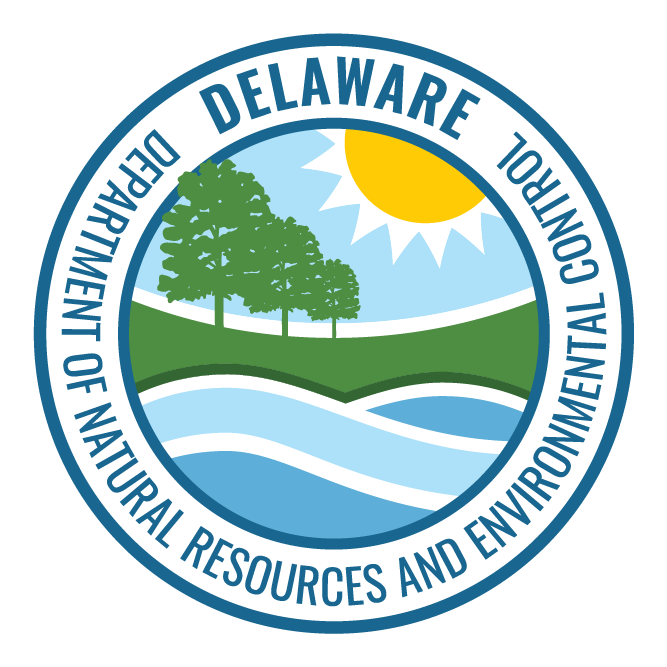Pages Tagged With: "water quality"
Chesapeake Implementation Program
The DNREC Chesapeake Implementation Program administers water quality focused programs and manages grants that fund projects within the Delaware portion of the Chesapeake Bay Watershed designed to reduce nonpoint source (NPS) pollution.Contact Us
Holly Walker 302-608-5458
Swimming Advisory Caution
The DNREC Recreational Water Program monitors bacterial water quality at established sampling sites throughout the state from May through September. If bacterial sampling results exceed state standards, DNREC issues swimming advisories for Atlantic Ocean beaches, as well as for Delaware Bay beaches south of and including Lewes Beach and for Lake Como in Smyrna.Navigating the Depths: Inside the Delaware Bay’s Longest-Running Water Quality Monitoring Program
The Delaware Estuary Water Quality Monitoring Program, informally known as the boat run, is one of the longest-running water quality monitoring programs in the world.Water Quality Monitoring
The Division of Water monitors ambient water quality and multiple sites around the state to help support multiple goals of the Department. It also tracks the causes and effects of saltwater intrusion. Ambient Groundwater Monitoring The Division of Water is expanding the number of existing groundwater monitoring wells throughoutWetlands and Waterways Applications
A listing of recent applications to the DNREC Division of Water for wetlands and subaqueous lands permits, leases and certifications.Wetlands and Waterways Applications
The DNREC Division of Watershed Stewardship and the U.S. Army Corps of Engineers have applied for subaqueous lands permits and water quality certifications to conduct dredging and beach replenishment along Lewes Beach.Vibrio Control Plans
Vibrio is a naturally occurring bacteria present in high levels in seawater when temperatures are warm. It can cause serious illness in humans. The National Shellfish Sanitation Program requires Delaware to implement plans to reduce the risk of Vibrio illnesses from oysters harvested in Delaware. Vibrio — Vibrio parahaemolyticus (V.p.) — canBlue-Green Algae in Delaware
Blue-green algae blooms occur each year on Delaware ponds, lakes and some tidal freshwater areas. Because they can have harmful effects on people and animals, the state has posted warning signs at water bodies which historically have had blooms.Contact Us
Public Hearing: Surface Water Quality Standards Triennial Review
The Division of Watershed Stewardship will conduct a public hearing on Wednesday, April 20, 2022, to consider comments from the public on proposed revisions to Delaware’s Surface Water Quality Standards.Delaware’s Section 303(d) Waters and Data Solicitation
The state has released a draft of its 2022 Combined Watershed Assessment Report for comments on DNREC’s tentative determination for Delaware’s 2022 Section 303(d) List.Local Government Guide to the Chesapeake Bay
The Local Government Guide to the Chesapeake Bay is a seven-module series created to support decision-making by local officials. A Local Government Guide to the Chesapeake Bay, a video introduction from the Chesapeake Bay Program.
Public Notice of Triennial Review of Water Quality Standards
The Department of Natural Resources and Environmental Control has begun a Triennial Review of Delaware’s Surface Water Quality Standards.Success Stories: Tappahanna Ditch
Runoff from agricultural areas caused high bacteria levels in Delaware’s Tappahanna Ditch of the Choptank River. As a result, the Delaware Department of Natural Resources and Environmental Control (DNREC) added the watershed to the 1996 Clean Water Act (CWA) section 303(d) list of impaired waters for bacteria and nutrients. Watershed stakeholders provided technical assistance andSuccess Stories: Iron Branch
Runoff from agricultural areas caused high bacteria levels in Delaware’s Iron Branch of Indian River Bay. As a result, the Delaware Department of Natural Resources and Environmental Control (DNREC) added the watershed to the 1996 Clean Water Act (CWA) section 303(d) list of impaired waters for bacteria. Watershed stakeholders provided technical assistance and installed agriculturalWetlands and Subaqueous Lands Permits
A list of applications to the DNREC Wetlands and Subaqueous Lands Section for permits, leases and water quality certifications.Conservation Reserve Enhancement Program
DNREC is part of a state and federal partnership with the USDA Commodity Credit Corporation, that aims to add up to 10,000 acres of Delaware agricultural land to the USDA Conservation Reserve Enhancement Program (CREP). Landowners in the CREP receive funding to support land conservation practices.Chesapeake Bay Projects
This page includes information on some of the projects undertaken by DNREC and its partners to help meet the goals of the Chesapeake Bay Watershed Implementation Plan. Related Information Best Management Practices StoryMap Redden StateChesapeake Bay Watershed Implementation Plan – Phase III
There have been three phases of Delaware’s Chesapeake Bay WIP. Delaware developed its Phase I WIP in 2010 and its Phase II WIP in 2012. Both the Phase I and Phase II WIPs describe actions and controls to be implemented by 2017 and 2025 to achieve applicable water quality standards. The Phase III WIP providesChesapeake Bay Watershed Implementation Plan – Phase I
Draft Phase I Watershed Implementation Plans (WIPs) were due to EPA on Sept. 1, 2010. Final plans were submitted on Nov. 29, 2010. Following the release of Delaware’s Draft Phase I WIP, numerous comments and questions from both EPA and various stakeholder groups within the watershed were submitted. As a result of comments andChesapeake Bay Watershed Implementation Plan – Phase II
Delaware’s Draft Phase II Watershed Implementation Plan for the Chesapeake Watershed was submitted to the EPA on Dec. 15, 2011. EPA reviewed the document and provided comments in Feb. 2012. Public comments were accepted through March 21, 2012. All suggestions were considered and the document was modified accordingly.Events and Workshops
The DNREC Nonpoint Source Program has hosted and participated in a series of events, workshops, and presentations designed to promote and support improvements to the quality of Delaware’s waterways. Recycled Cardboard Boat Regatta (Aug. 5, 2023) Nonpoint Source Program staff participated in the Recycled Cardboard Boat RegattaChesapeake Bay Milestones
To continue accelerating progress toward meeting water quality goals, the EPA and Chesapeake Bay Program jurisdictions, including Delaware, agreed to set interim two-year milestones – or short-term goals – as a critical part of an accountability framework. ChesapeakeStat Find data and informationChesapeake Bay Watershed Implementation Plan
Delaware is among six Chesapeake Bay Watershed states – along with Maryland, Virginia, West Virginia, Pennsylvania, and New York – and the District of Columbia committed to a federal-state initiative to develop a pollution “diet” that will help restore the water quality of the Bay and its tidal waters by 2025. [column md=”5″ xclass=”col-xs-12Verification of Best Management Practices
The implementation, tracking and reporting of Best Management Practices (BMPs) has been at the center of the Chesapeake Bay Program partnership’s restoration efforts for almost three decades. Properly installed and functioning practices and technologies reduce local flooding, protect sources of drinking water, ensure against the collapse of stream banks, andWatershed Plans and Strategies
Numerous documents describing plans or strategies for water quality and watershed improvements have been developed over the years. Some of these efforts originated through the Tributary Action Team process while others came through other initiatives. All of the documents below can be considered watershed management plans for the Water Quality Improvement Projects grant programPollution Control Strategies and Tributary Action Teams
A 1997 federal court case required Delaware to set pollution limits for its waterways. These limits are called Total Maximum Daily Loads or TMDLs, a term you will hear a lot in water pollution discussions. In order to meet these new pollution limits, we are identifying ways to reduce water pollution. Usually, citizens don’tTotal Maximum Daily Loads
When monitoring reveals that waterways do not meet Delaware’s water quality standards, they are reported on a list of impaired waterways (303(d) List). For each impaired waterway, the Federal Clean Water Act (CWA) requires states to develop Total Maximum Daily Loads (TMDLs) for the pollutants of concern. A TMDL sets a limit on the amountIntegrated Report: 305(b) Report and 303(d) List
Section 305(b) of the Federal Clean Water Act requires that states and other entities prepare and submit Watershed Assessment Reports to the US EPA on April 1 of every even-numbered year.Contact Us
Watershed Assessment and Managment Section 302-739-9939
You Can Help Protect Delaware’s Waterways
There are always things that you can do in your everyday life, no matter where you live, to help protect the waterways that serve as our drinking water sources, habitat for wildlife, and places of recreation. Maintain a Healthy Lawn and Garden A healthy lawn and garden makes a home moreWatershed Assessment and Management
The Watershed Assessment and Management Section oversees the health of the state’s surface water resources and takes actions to protect and improve water quality for aquatic life and human use.Contact Us
Michael Bott 302-739-9939
Whole Basin Management
Beginning in the 1990s, the Department of Natural Resources and Environmental Control (DNREC) took a different approach to assessing, managing, and protecting Delaware’s natural resources. This approach, known as Whole Basin Management, encouraged the various programs throughout DNREC to work in an integrated manner to assess different geographic areas of the state defined on theProtecting Our Waterways
There are many things each of us can do to help reduce nutrient and sediment pollution entering Delaware’s waterways. Our efforts will not only help protect the environment, but in many cases, when you lend a hand to protect our waterways, you will also find that you’re adding beauty to your yard, saving energy,Water Quality Monitoring
Delaware’s bays, ponds, streams, and rivers are monitored on a regular basis to assess the quality of Delaware’s surface waters. Much of the monitoring is done by DNREC, though other groups, including federal agencies, academic institutions, and citizen volunteer monitoring programs, also contribute to these efforts.Inland Bays Pollution Control Strategy
The Inland Bays Pollution Control Strategy (PCS) and accompanying regulations were finalized in Nov. 2008. This strategy is designed to improve the water quality of the bays (Rehoboth Bay, Indian River Bay, and Little Assawoman Bay), as well as the rivers, streams, and ponds that drain to the bays. ADVISORY: A legal challenge toSurface Water Quality Standards
The National Clean Water Act of 1972 set in place a program that is intended to restore the chemical, physical, and biological integrity of the nation’s waters. To reach these goals, a series of steps were mandated by Congress for the Environmental Protection Agency and the individual States to take. The first step was forPromoting Shellfish Safety
To ensure the safety of Delaware’s shellfish growing areas, it is important that residents and visitors help maintain good water quality and limit pollution while recreating in or near shellfish growing areas.Contact Us
Andrew Bell Environmental Scientist 302-739-9939
Shellfish Plant Inspections
Plant inspections of all shellfish shippers and processors are conducted routinely by certified Shellfish Program staff to ensure compliance with national food safety regulations and those specific to the shellfish industry.Contact Us
Delaware Shellfish Program
The DNREC Shellfish Program is responsible for protecting public health by minimizing the risk of food borne illness due to the consumption of shellfish. Growing Waters and Plant Inspections Andrew Bell Environmental Scientist 302-739-9939 Enforcement Natural Resources Police 302-739-9913Eco-Explorers Virtual Field Trip Registration
This form is for teachers and homeschool groups to register for an Eco-Explorers virtual field trip with the Aquatic Resources Education Center. There is no charge for the field trip but please register if you plan to use the virtual field trip material. This will help us provide additional programs in the future.Virtual Eco-Explorers Field Trip Program
The Aquatic Resources Education Center offers a virtual version of the Eco-Explorers field trip program. The resources of the virtual field trip are useful for students or school groups unable to attend traditional, in-person field trips and as supplementary and review material for in-person field trip participants.Success Stories: Pike Creek
Pike Creek is in northern New Castle County and is a tributary of White Clay Creek within the White Clay Creek subbasin. The lower portions of the White Clay Creek are tidally influenced. In 2000, the President signed a law adding 190 miles of the White Clay Creek and its tributaries to the National WildBiennial NPS Training and Meeting
The DNREC Nonpoint Source Program (NPS), in partnership with Environmental Protection Agency (EPA) Region 3, hosted the 2019 Mid-Atlantic Nonpoint Source Program Training and Meeting in October of 2019. The states in the EPA Region 3 (Delaware, Maryland, Virginia, Pennsylvania, and West Virginia) take turns hosting this biennial event. The next meeting, in 2021,Success Stories: Trap Pond
Southern Delaware’s Trap Pond is a tributary of Broad Creek, which drains to the Nanticoke River and flows to the Chesapeake Bay. This area has a unique ecology, as it is home to the northernmost natural stand of bald cypress in the United States. The area also contains a 2,000-acre wetland, one of the largestSuccess Stories: Gravelly Branch
Southern Delaware’s Gravelly Branch watershed drains into the Nanticoke River, which flows into the Chesapeake Bay. Gravelly Branch begins in the town of Ellendale and flows toward the city of Seaford. The major land use in the 24,423-acre Gravelly Branch watershed is agriculture. SuccessSuccess Stories: Upper Marshyhope Creek
The Delaware portion of the Marshyhope Creek watershed (Upper Marshyhope Creek) lies within Kent and Sussex counties on the western edge of Delaware. The creek flows into Maryland before eventually discharging into the Nanticoke River, which in turn empties into the Chesapeake Bay. The drainage area of the Marshyhope Creek watershed within Delaware is approximatelySuccess Stories: Cow Bridge Branch
Stockley Branch flows into Cow Bridge Branch watershed, which spans 28,676 acres and is located in the Indian River watershed in southeastern Sussex County. The Indian River Bay watershed makes up one of three of Delaware’s interconnected Inland Bays (Rehoboth Bay, Indian River Bay, and Little Assawoman Bay). [button type=”primary”Success Stories: Little Assawoman Bay
Little Assawoman Bay — the smallest of Delaware’s Inland Bays — is connected to Indian River Bay on the north by the Assawoman Canal and to Assawoman Bay on the south via a narrow channel. The Little Assawoman Bay watershed is an agriculture-dominated watershed covering three square miles with no influencing point sources. The areaSuccess Stories: Noxontown Pond
Noxontown Pond covers approximately 158 acres near the headwaters of the Appoquinimink River watershed. This watershed contains three of the fastest developing municipalities in the state – Odessa, Townsend, and Middletown. While much of this watershed was historically agricultural, increased development has led to the conversion of farms into suburban residential communities. Less than 9%Success Stories: Records Pond
Records Pond, also known as Laurel Lake, was created in 1900 with the completion of the Records Pond Dam on Broad Creek. Although Records Pond is just over 90 acres, it is one of the larger lakes in Delaware. Almost at sea level, and with a maximum depth of 10 feet, the pond is relativelySuccess Stories: Coursey Pond
Coursey Pond, in southeast Kent County, is a 58-acre pond draining to the Murderkill River, a tributary to the Delaware Bay. The headwaters of the Murderkill River begin just west of Felton and flow towards Bowers Beach, with the lower 10.5-mile portion of the river influenced by tides. The Coursey Pond area is home toPage: 12 of 2 total pages




